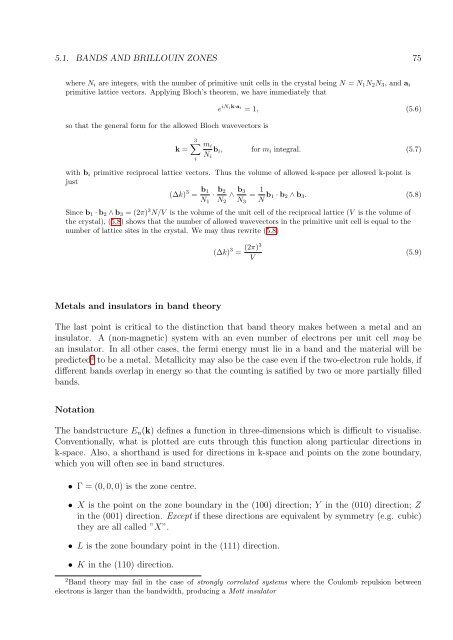Set of supplementary notes.
Set of supplementary notes.
Set of supplementary notes.
Create successful ePaper yourself
Turn your PDF publications into a flip-book with our unique Google optimized e-Paper software.
5.1. BANDS AND BRILLOUIN ZONES 75<br />
where N i are integers, with the number <strong>of</strong> primitive unit cells in the crystal being N = N 1 N 2 N 3 , and a i<br />
primitive lattice vectors. Applying Bloch’s theorem, we have immediately that<br />
so that the general form for the allowed Bloch wavevectors is<br />
e iNik·ai = 1, (5.6)<br />
k =<br />
3∑<br />
i<br />
m i<br />
N i<br />
b i , for m i integral. (5.7)<br />
with b i primitive reciprocal lattice vectors. Thus the volume <strong>of</strong> allowed k-space per allowed k-point is<br />
just<br />
(∆k) 3 = b 1<br />
N 1<br />
· b2<br />
N 2<br />
∧ b 3<br />
N 3<br />
= 1 N b 1 · b 2 ∧ b 3 . (5.8)<br />
Since b 1 · b 2 ∧ b 3 = (2π) 3 N/V is the volume <strong>of</strong> the unit cell <strong>of</strong> the reciprocal lattice (V is the volume <strong>of</strong><br />
the crystal), (5.8) shows that the number <strong>of</strong> allowed wavevectors in the primitive unit cell is equal to the<br />
number <strong>of</strong> lattice sites in the crystal. We may thus rewrite (5.8)<br />
(∆k) 3 = (2π)3<br />
V<br />
(5.9)<br />
Metals and insulators in band theory<br />
The last point is critical to the distinction that band theory makes between a metal and an<br />
insulator. A (non-magnetic) system with an even number <strong>of</strong> electrons per unit cell may be<br />
an insulator. In all other cases, the fermi energy must lie in a band and the material will be<br />
predicted 2 to be a metal. Metallicity may also be the case even if the two-electron rule holds, if<br />
different bands overlap in energy so that the counting is satified by two or more partially filled<br />
bands.<br />
Notation<br />
The bandstructure E n (k) defines a function in three-dimensions which is difficult to visualise.<br />
Conventionally, what is plotted are cuts through this function along particular directions in<br />
k-space. Also, a shorthand is used for directions in k-space and points on the zone boundary,<br />
which you will <strong>of</strong>ten see in band structures.<br />
• Γ = (0, 0, 0) is the zone centre.<br />
• X is the point on the zone boundary in the (100) direction; Y in the (010) direction; Z<br />
in the (001) direction. Except if these directions are equivalent by symmetry (e.g. cubic)<br />
they are all called ”X”.<br />
• L is the zone boundary point in the (111) direction.<br />
• K in the (110) direction.<br />
2 Band theory may fail in the case <strong>of</strong> strongly correlated systems where the Coulomb repulsion between<br />
electrons is larger than the bandwidth, producing a Mott insulator








